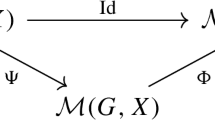Abstract
(1) Suppose \(\mu \) is a smooth measure on a smooth hypersurface of positive Gaussian curvature in \({\mathbb {R}}^{2n}\). If \(n\ge 2\), then \(W(\mu )\), the Weyl transform of \(\mu \) is a compact operator, and if \(p>n\ge 6\), then \(W(\mu )\) belongs to the p-Schatten class. (2) There exist Schatten class operators with linearly dependent quantum translates.
Similar content being viewed by others
References
Chavel I, Riemannian geometry, Cambridge Studies in Advanced Mathematics, vol. 98 (2006) (Cambridge: Cambridge University Press)
Edgar G A and Rosenblatt J M, Difference equations over locally compact abelian groups, Trans. Amer. Math. Soc. 253 (1979) 273–289
Folland G B (1989) Harmonic analysis in phase space, Annals of Mathematics Studies, vol. 122 (Princeton, NJ: Princeton University Press)
Folland G B, Introduction to partial differential equations, second ed. (1995) (Princeton, NJ: Princeton University Press)
Guillemin V and Pollack A, Differential topology (1974) (Englewood Cliffs, NJ: Prentice-Hall Inc.)
Hopf H, Differential geometry in the large, Lecture Notes in Mathematics, vol. 1000 (1983) (Berlin: Springer-Verlag), Notes taken by Peter Lax and John Gray, with a preface by S S Chern
Hörmander L, The analysis of linear partial differential operators. I, second ed., Grundlehren der mathematischen Wissenschaften (Fundamental Principles of Mathematical Sciences), vol. 256 (1990) (Berlin: Springer-Verlag), Distribution theory and Fourier analysis
Mumford D, Tata lectures on theta. III, Progress in Mathematics, vol. 97 (1991) (Boston, MA: Birkhäuser Boston Inc.), with the collaboration of Madhav Nori and Peter Norman
Rudin W, Functional analysis, second ed., International Series in Pure and Applied Mathematics, (1991) (New York: McGraw-Hill Inc.)
Stein E M, Harmonic analysis: real-variable methods, orthogonality, and oscillatory integrals, Princeton Mathematical Series, vol. 43 (1993) (Princeton, NJ: Princeton University Press), with the assistance of Timothy S Murphy, Monographs in Harmonic Analysis, III
Szegö G, Orthogonal Polynomials, American Mathematical Society Colloquium Publications, vol. 23 (1939) (New York: American Mathematical Society)
Thangavelu S, Spherical means on the Heisenberg group and a restriction theorem for the symplectic Fourier transform, Rev. Mat. Iberoamericana 7(2) (1991) 135–155
Thangavelu S, On Paley–Wiener theorems for the Heisenberg group, J. Funct. Anal. 115(1) (1993) 24–44
Thangavelu S, Harmonic analysis on the Heisenberg group, Progress in Mathematics, vol. 159 (1998) (Boston, MA: Birkhäuser Boston Inc.)
Vemuri M K, Realizations of the canonical representation, Proc. Indian Acad. Sci. – Math. Sci. 118(1) (2008) 115–131
Vemuri M K, Benedicks’ theorem for the Weyl transform, J. Math. Anal. Appl. 452(1) (2017) 209–217
Acknowledgements
The authors would like to thank the anonymous referee for a suggestion which substantially simplified the original argument.
Author information
Authors and Affiliations
Corresponding author
Additional information
Communicated by Sameer Chavan.
Appendix
Appendix
We prove Lemma 2.2 here. We need another technical lemma.
Lemma A.1
Let M be a compact connected smooth hypersurface in \({\mathbb {R}}^m\) with positive Gaussian curvature. Let H be an affine subspace of \({\mathbb {R}}^m\) and suppose H intersects M transversally. Let \(N=M\cap H\). Then N is a smooth hypersurface in H, and for all \(y\in N\) and \(X, Y \in T_yN\), we have
where \(K_{(N \subseteq H)}\) and \(K_{(M \subseteq {\mathbb {R}}^m)}\) are the second fundamental forms with respect to the inward pointing normal on the smooth hypersurfaces N and M respectively.
Proof
By the Jordan–Brower separation theorem, \(M=\partial \Omega \) where \(\Omega \) is a bounded open set in \({\mathbb {R}}^m\). Let \(\vec {n}_M\) denote the unit normal to M which points into \(\Omega \). Let \(N=M\cap H\). It is a standard fact from differential topology that N is a smooth hypersurface in H (see [5, p. 30]). Let \(\vec {n}_N\) denote the unit normal vector to N which points into \(\Omega \cap H\). Observe that \(\vec {n}_N\cdot \vec {n}_M>0\).
If W is a submanifold of the Riemannian manifold Z, let \(\vec {K}_{(W \subseteq Z)}\) denote the vector-valued second fundamental form of W in Z, i.e.,
where \(\nabla \) is the Levi–Civita connection on Z and \(TZ \ominus TW\) denotes the orthogonal complement of the tangent bundle of W in the tangent bundle of Z. Moreover, if \(\vec n\) is a unit normal vector field along W, we may define the second fundamental form of W with respect to \(\vec n\) by
Let \(x\in N\) and let \(X, Y \in T_xN\). We have orthogonal decompositions
Since \(\vec {K}_{(H \subseteq {\mathbb {R}}^m)}(X,Y)=0\), it follows that
Since \(\vec {K}_{(N \subseteq M)}(X,Y)\) is tangent to M, it follows that
Therefore
Taking \(H=\{(x,y) \,|\,y \in {\mathbb {R}}^n\}\) in Lemma A.1, we see that \(S_x\) is a smooth hypersurface in H with \(K_{(S_x \subseteq H)}(X,Y) \ge K_{(S \subseteq {\mathbb {R}}^{2n})}(X,Y)\). Since \(\Pi _2\) is an isometry between H and \({\mathbb {R}}^n\), it follows that \(\Pi _2(S_x)\) is a smooth hypersurface in \({\mathbb {R}}^n\) with \(K_{(\Pi _2(S_x) \subseteq {\mathbb {R}}^n)}(X,Y) \ge K_{(S \subseteq {\mathbb {R}}^{2n})}(X,Y)\). Therefore the smallest principal curvature of \(\Pi _2(S_x)\) is greater than or equal to the smallest principal curvature of S. Therefore the Gaussian curvature of \(S_x\) is bounded below by the \((n-1)\)-th power of the smallest principal curvature of S.
Rights and permissions
About this article
Cite this article
Mishra, M., Vemuri, M.K. The Weyl transform of a measure. Proc Math Sci 133, 29 (2023). https://doi.org/10.1007/s12044-023-00748-0
Received:
Revised:
Accepted:
Published:
DOI: https://doi.org/10.1007/s12044-023-00748-0



